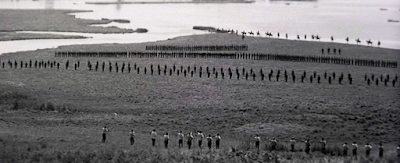“THE GREATEST HUNGARIAN FILM DIRECTOR OF ALL TIME” - Béla Tarr
The above words by Tarr are featured on Kino Lorber’s recent six film disc set of Miklós Jancsó:
The Round-Up (1966)
The Red and the White (1967)
The Confrontation (1969)
Winter Wind (1969)
Red Psalm (1972)
Electra, My Love (1974)
The sweeping camera movements, the sideways camera pan, found in Jancsó’s films clearly has an influence on Tarr’s films in terms of shot composition. Although, Tarr’s camera rhythm and pan speed is slighter slower than Jancsó's and that is due to the differing focus and topics the two directors want to cover.
Jancsó’s films are concerned with the fate of a society or nation in general and as a result, characters in his film are involved in debates between capitalism vs socialism, industrial vs agricultural ways of living. Depiction of these debates are shown via sweeping camera movements as the camera moves across a diverse array of characters, rival groups and fighting armies who are debating these lofty ideals and the fate of society.
The camera has a lot of ground to cover in Jancsó's films because there are multiple viewpoints that need to be shown and these beautiful measured camera movements engulf an entire universe as individuals slowly blend into a larger mosaic. Jancsó also shows the impact of authoritarian rule which crushes individuals and his films depict the sexual abuse committed by men (soldiers or those in power). On the other hand, Tarr’s camera wants us to focus on 1-2 characters in its movements. Sometimes, Tarr’s camera wants us to focus on objects as the characters are not in the frame. There are crimes committed in Tarr’s films as well but those are mostly individual in nature or undertaken by a few against a small community.
Another difference between the two directors is regarding the mood in the films, which includes the colour palette and background noise. The sound of the landscape, rain and environment, filters through more in Tarr’s films whereas in Jancsó’s films, it is songs, music, spirited debates and gunfire that come through. Tarr’s films feature dark or grayish palettes with rain and gloomy skies. On the other hand, Jancsó’s films are packed with bright lively skies in the four colour films in the above set (The Confrontation, Winter Wind, Red Psalm and Electra, My Love). This is true even in Winter Wind where the snow doesn’t appear gloomy at all.
Miklós Jancsó’s films take real life events in Hungarian society and bring them to life. However, the manner in which the films are shot have a universality to them. This is due to the films being shot in open fields which turns the focus more on the words and actions of the characters. The crimes the men commit and their unflinching loyalty to their cause are still applicable in today’s world as the world is more divided than ever with men willing to go to any lengths to justify their cause.
There is plenty of good writing on Jancsó’s films. Here are just a few worthy ones:
1. Richard Brody in New Yorker
2. J. Hoberman in Film Comment
"First manifest in The Round-Up (65), Jancsó’s boldly stylized film language appeared to be a synthesis of Antonioni (elegant widescreen compositions, austere allegorical landscapes), Bresson (impassive performers, exaggerated sound design), and Welles (convoluted tracking shots, intricately choreographed ensembles), even as his free-floating existential attitudes and “empty world” iconography evoked the theater of the absurd, albeit without the laughs. Jancsó’s subject or, rather, his prison, was history. His narratives recalled the literature of extreme situations-pivoting on cryptic betrayals, mapping the seizure of power, dramatizing the exercise of terror- and his politics were ambiguously left, perhaps crypto-Trotskyist."
3. Patrick Dahl in Screenslate:




No comments:
Post a Comment